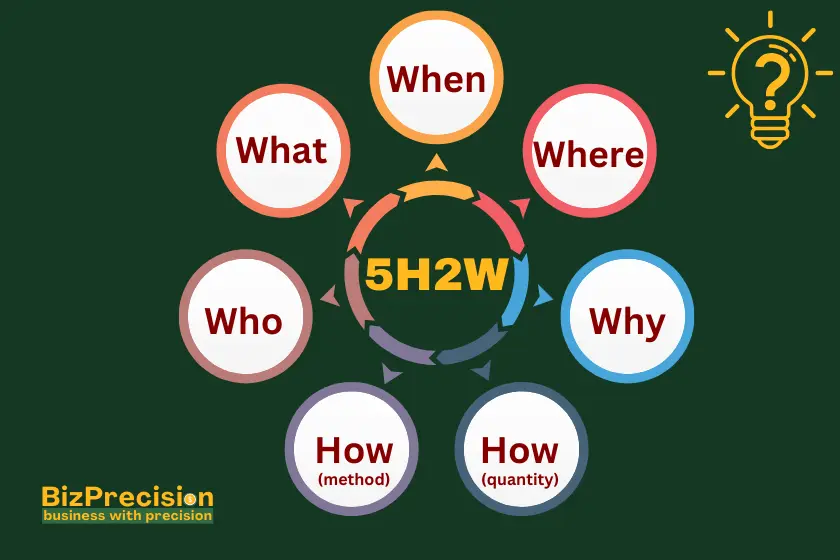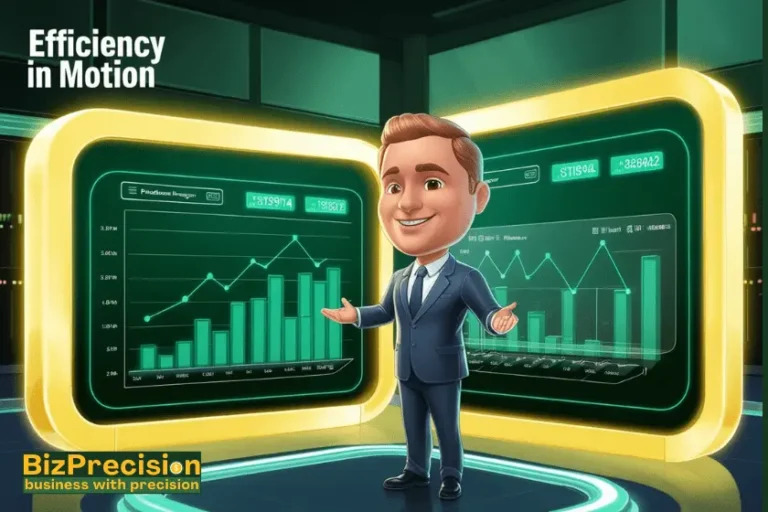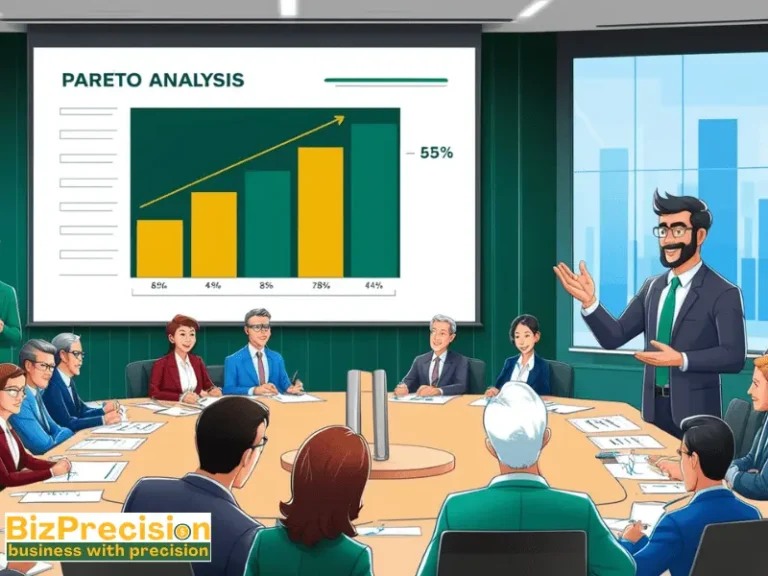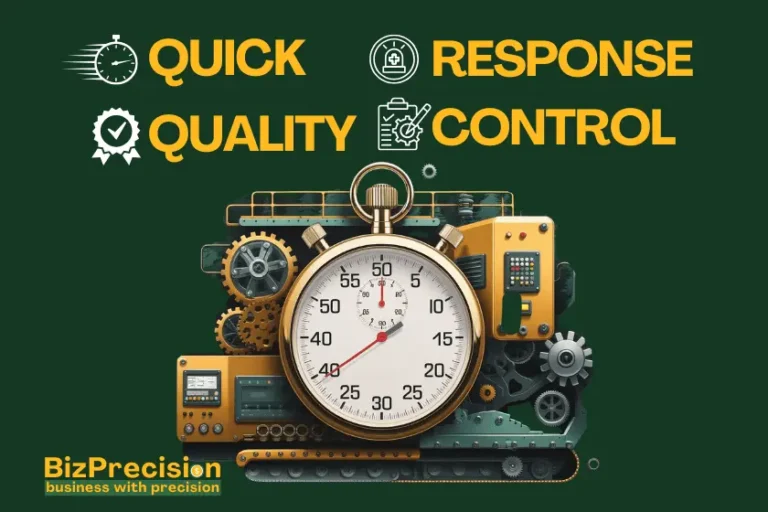Mastering the 5W2H Approach: Enhance Your Problem-Solving Skills
Do challenges leave you feeling overwhelmed? Struggling to find clear, actionable solutions? The 5W2H approach is your secret weapon for simplifying complex problems. Whether you’re tackling business challenges, engineering projects, or personal goals, this structured framework provides clarity and actionable steps to achieve success.
In this guide, you’ll learn:
- What the 5W2H approach is and why it works.
- How to apply it in business, personal development, and crisis management.
- Real-world examples and actionable tips to master this powerful tool.
Let’s dive in!
What is 5W2H Approach
The 5W2H approach is a problem-solving framework rooted in project management. It involves asking seven key questions:
- Who
- What
- When
- Where
- Why
- How
- How Much
These questions guide you through every critical aspect of a problem, ensuring you address both symptoms and root causes. According to a 2022 study by the Project Management Institute, structured frameworks like 5W2H improve decision-making efficiency by 40%.
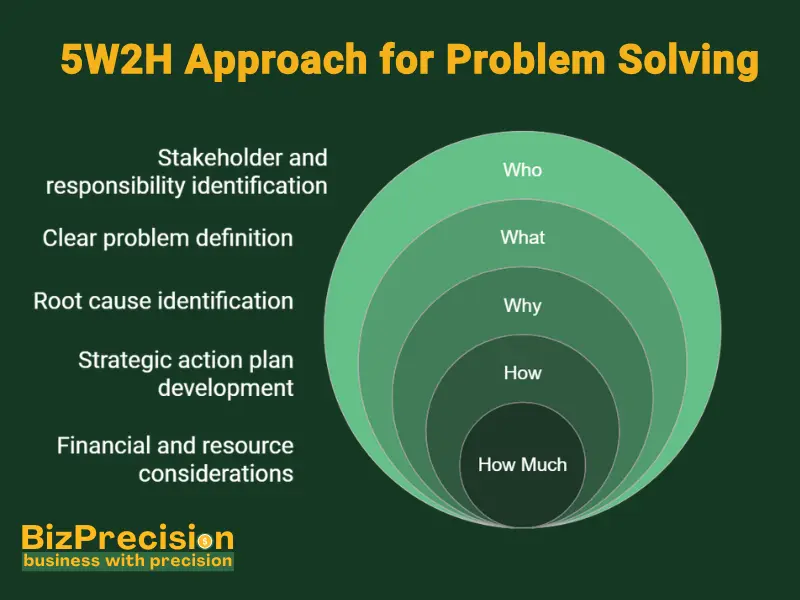
1. Who: Identifying Stakeholders and Responsibilities
The first step is to identify everyone involved in the problem. This includes:
- Affected parties: Those impacted by the issue.
- Decision-makers: Individuals with the authority to implement solutions.
- Contributors: Team members who will execute the plan.
Example: In a retail setting, the “Who” might include the stock manager, floor staff, and customers affected by stock-outs.
Pro Tip: Clearly define roles and responsibilities to ensure accountability and alignment.
2. What: Clearly Defining the Problem
A well-defined problem is halfway to being solved. Avoid vague descriptions and focus on specifics. Ask yourself:
- What exactly is the issue?
- How would I explain it to someone unfamiliar with the situation?
Example: Instead of saying, “Our sales are down,” specify, “Sales of Product X dropped by 15% in Q2 due to supply chain delays.
”Pro Tip: Use data to support your problem statement. For instance, “Customer complaints about slow internet increased by 20% last month.
3. When: Setting Realistic Timelines
Time management is critical to problem-solving. Establish realistic deadlines for each phase of the process, considering:
- The complexity of the problem.
- Available resources.
- Potential bottlenecks.
Example: If you’re addressing customer service response times, set a goal like, “Reduce average response time from 24 hours to 12 hours within three months.”
Pro Tip: Use project management tools like Trello or Asana to track progress and stay on schedule.
4. Where: Considering the Context
Environmental and contextual factors play a crucial role in problem-solving. Ask:
- Where is the problem occurring?
- Are there specific locations or conditions contributing to the issue?
Example: When tackling urban traffic congestion, consider factors like city layout, public transport availability, and peak traffic hours.
Pro Tip: Conduct a site visit or gather data from affected areas to better understand the context.
5. Why: Uncovering the Root Cause
Surface-level solutions rarely work. Use the 5 Whys technique to dig deeper:
- Why is the problem happening?
- Why does that cause exist?
- Continue asking “why” until you uncover the root cause.
Example:
- Problem: Customers complain about slow internet.
- Why? The router is overloaded.
- Why? The firmware is outdated.
- Why? The IT team hasn’t updated it in six months.
Root Cause: Lack of regular maintenance.
Pro Tip: Document each “why” to create a clear trail of reasoning.
6. How: Developing a Strategic Action Plan
With a clear understanding of the problem, outline a detailed plan to address it. Break the solution into manageable steps:
- What actions are needed?
- What resources are required?
- Who is responsible for each task?
Example: To improve customer service response times:
- Step 1: Train staff on efficient communication.
- Step 2: Implement a ticketing system to track inquiries.
- Step 3: Monitor progress weekly and adjust as needed.
Pro Tip: Use SMART goals (Specific, Measurable, Achievable, Relevant, Time-bound) to ensure your plan is actionable.
7. How Much: Estimating Costs and Resources
Every solution comes with a price tag. Estimate:
- The financial cost of implementing the solution.
- The resources (time, personnel, tools) required.
- The potential return on investment (ROI).
Example: Upgrading inventory systems might cost $10,000 but could reduce stock-outs by 30%, leading to higher customer satisfaction and sales.
Pro Tip: Use cost-benefit analysis to justify your solution to stakeholders.
Real-World Applications of 5W2H
Case Study 1: Toyota’s Lean Manufacturing System
Toyota, a global leader in automotive manufacturing, has long used structured problem-solving frameworks like 5W2H to optimize production processes. In one instance, Toyota faced delays in its production line due to inconsistent parts delivery.
- Who: Identified the production manager, suppliers, and assembly line workers as key stakeholders.
- What: Defined the issue as “delays in parts delivery causing production bottlenecks.”
- Why: Discovered the root cause was poor communication between suppliers and the production team.
- How: Implemented a Just-in-Time (JIT) inventory system to streamline parts delivery.
- How Much: Invested $1 million in supplier training and system upgrades.
Results: Toyota reduced production cycle times by 27%, as documented in McKinsey’s 2023 report on Lean Manufacturing.
Case Study 2: IBM’s Predictive Analytics Implementation
IBM faced challenges with server downtime, which impacted customer satisfaction and operational efficiency. Using the 5W2H approach, they:
- Who: Identified the IT team, data scientists, and customer support representatives as key players.
- What: Defined the issue as “frequent server downtime affecting customer operations.”
- Why: Determined the root cause was outdated server hardware and insufficient predictive maintenance.
- How: Developed a predictive analytics model to monitor server health and schedule maintenance proactively.
- How Much: Invested $2.5 million in technology upgrades and staff training.
Results: IBM reduced server downtime by 40%, as reported in a 2022 Harvard Business Review article .
Case Study 3: Starbucks’ Crisis Management
In 2015, Starbucks faced a public relations crisis when customers complained about inconsistent coffee quality across stores. Using the 5W2H framework, they:
- Who: Identified store managers, baristas, and corporate leadership as key stakeholders.
- What: Defined the issue as “inconsistent coffee quality leading to customer dissatisfaction.”
- Why: Discovered the root cause was inconsistent training and lack of standardized brewing processes.
- How: Implemented a global training program and introduced standardized brewing equipment.
- How Much: Invested $10 million in training and equipment upgrades.
Results: Customer satisfaction scores improved by 25%, as reported in Starbucks’ 2016 Annual Report .
Advanced Techniques to Complement 5W2H
While the 5W2H approach is a powerful tool, combining it with other problem-solving frameworks can yield even better results. Here are two complementary techniques:
1. SWOT Analysis
SWOT (Strengths, Weaknesses, Opportunities, Threats) analysis helps you evaluate internal and external factors affecting your problem.
- How to Use It with 5W2H:
- Strengths: Identify what you’re doing well (e.g., “Our team has strong technical skills”).
- Weaknesses: Pinpoint areas for improvement (e.g., “We lack a centralized communication system”).
- Opportunities: Explore external factors you can leverage (e.g., “New software can automate our processes”).
- Threats: Identify potential risks (e.g., “Competitors are launching similar products”).
Example: A startup used SWOT alongside 5W2H to identify gaps in its marketing strategy. By addressing weaknesses (e.g., limited social media presence) and leveraging opportunities (e.g., influencer partnerships), they increased brand awareness by 35% in six months.
2. The 5 Whys Technique
The 5 Whys technique helps you dig deeper into the root cause of a problem by repeatedly asking “why.”
- How to Use It with 5W2H:
- Start with the problem (e.g., “Sales are declining”).
- Ask “why” five times to uncover the root cause (e.g., “Why are sales declining? Because customer retention is low. Why is retention low? Because product quality has dropped.”).
Example: A manufacturing company used the 5 Whys to identify a recurring defect in their products. By addressing the root cause (e.g., outdated machinery), they reduced defects by 50% and saved $1 million annually.
Common Pitfalls to Avoid
Even with a structured framework like 5W2H, mistakes can happen. Here are some common pitfalls and how to avoid them:
1. Focusing Only on Symptoms
- Pitfall: Addressing surface-level issues without uncovering the root cause.
- Solution: Use the 5 Whys technique to dig deeper.
2. Overlooking Stakeholder Input
- Pitfall: Failing to involve key stakeholders in the problem-solving process.
- Solution: Engage all relevant parties early and gather diverse perspectives.
3. Rushing Through the Process
- Pitfall: Skipping steps or making hasty decisions.
- Solution: Take time to thoroughly analyze each question (Who, What, When, Where, Why, How, How Much).
4. Ignoring Data and Feedback
- Pitfall: Relying on assumptions instead of data.
- Solution: Collect and analyze relevant data to inform your decisions.
Applying 5W2H to Personal Development
The 5W2H approach isn’t just for business—it’s also a powerful tool for personal growth. Here’s how you can use it to achieve your goals:
Step 1: Define Your Goal
- What: Clearly state what you want to achieve (e.g., “I want to lose 10 pounds”).
- Why: Identify your motivation (e.g., “To improve my health and energy levels”).
Step 2: Identify Resources and Support
- Who: Determine who can help you (e.g., a fitness coach, nutritionist, or accountability partner).
- Where: Decide where you’ll work toward your goal (e.g., at home, the gym, or a local park).
Step 3: Create a Plan
- How: Break your goal into actionable steps (e.g., “Exercise 4 times a week, track calories, and drink more water”).
- When: Set a timeline (e.g., “Lose 10 pounds in 3 months”).
- How Much: Estimate the resources needed (e.g., “Spend $200 on a gym membership and healthy groceries”).
Example: Sarah used the 5W2H approach to transition to a new career. By defining her goal (e.g., “Become a data analyst”), identifying resources (e.g., online courses, mentors), and creating a timeline, she landed her dream job in 6 months.
Step-by-Step Guide to Applying 5W2H
Here’s a visual guide to help you apply the 5W2H framework effectively:
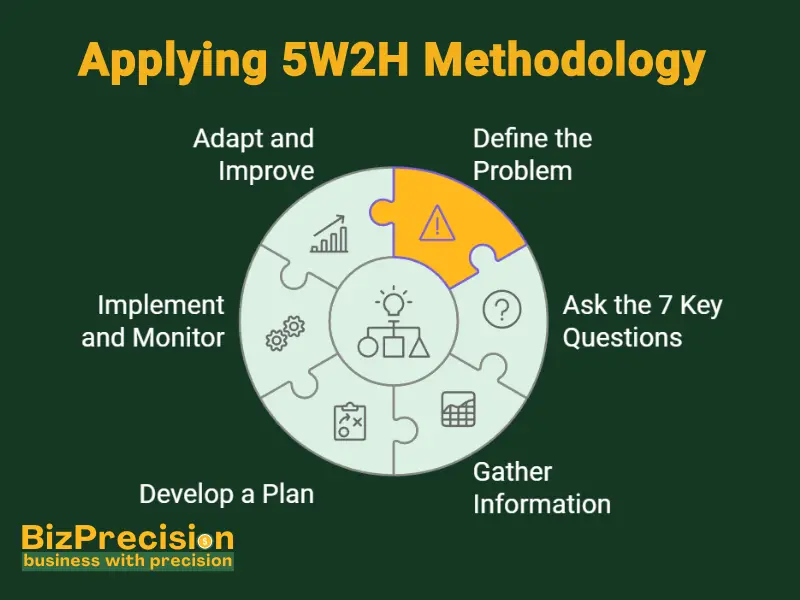
- Define the Problem or Opportunity: Clearly identify the situation you’re addressing.
- Ask the 7 Key Questions: For each situation, ask Who, What, When, Where, Why, How, and How Much.
- Gather Information: Research and collect data to answer each question comprehensively.
- Develop a Plan: Create a detailed action plan with clear steps and deadlines.
- Implement and Monitor: Launch your plan and track progress regularly.
- Adapt and Improve: Adjust your approach based on feedback and new information.
Measuring Success with 5W2H
To evaluate the effectiveness of your 5W2H implementation, track key metrics and indicators:
- Key Performance Indicators (KPIs): Measure progress toward your goals (e.g., reduced response times, increased sales).
- Feedback: Gather input from stakeholders to identify areas for improvement.
- Continuous Improvement: Regularly revisit your plan and make adjustments as needed.
Example: A customer service team used 5W2H to reduce response times. By tracking KPIs (e.g., average response time, customer satisfaction scores) and gathering feedback, they achieved a 20% improvement within three months.
FAQ’s
Conclusion
The 5W2H approach is a versatile, structured framework that can transform the way you solve problems—whether in business, personal development, or crisis management. By asking the right questions and addressing both symptoms and root causes, you can achieve lasting, impactful solutions.
Key Takeaways:
- The 5W2H framework provides clarity and structure to problem-solving.
- It’s adaptable and applicable across industries and personal goals.
- Combining 5W2H with complementary techniques like SWOT and the 5 Whys enhances its effectiveness.
- Avoid common pitfalls by involving stakeholders, gathering data, and taking a thorough, methodical approach.
Next Steps:
- Download our free 5W2H Template to start solving problems effectively today.
- Share your success stories with us! How have you used the 5W2H approach to achieve your goals?
Remember, problem-solving is a skill that improves with practice

